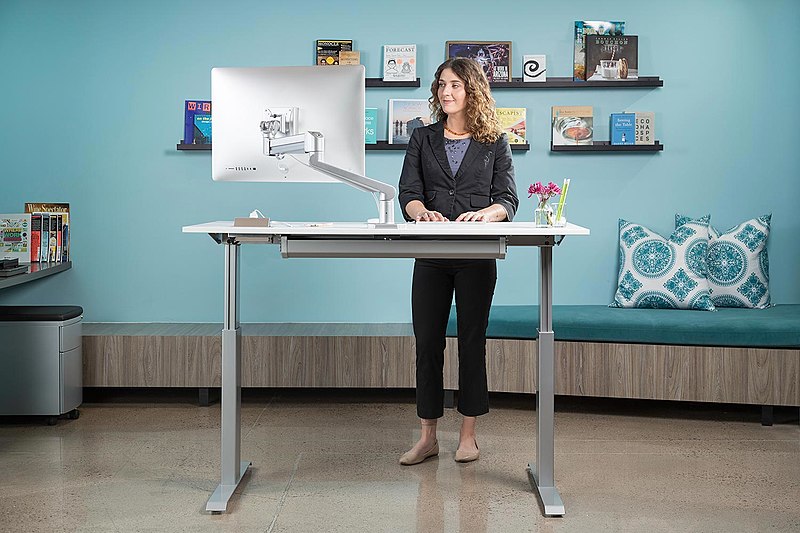Workplace environment and etiquette have been undergoing massive transformations with the advent of technology. Today’s office spaces have become more compact and personalized, with an overall objective to increase efficiency and productivity. Contemporary co-working spaces have been revolutionary in these aspects. An additional factor that becomes relevant here is the “workplace wellness” in any organization. And this is where office ergonomics come into the picture.
Technically, ergonomics involves the process of designing or arranging components in a workplace, including all systems and products, in a way that’s most beneficial to those using them. Studies have shown that ergonomics is vital to the functioning of an office, as it has a direct effect on the occurrence of work-related injuries or illnesses and on the increase of efficiency and morale. Workplace wellness ideas and wellness programs at work have been increasing lately due to the same reasons.
Here are a few measures that can be employed to enhance health and improve wellness ideas in the workplace.
Provide Good Seating
Posture is an obvious determinant of the productivity of a person. Awkward seating positions that result from setup mismatches can affect the pace of the work and accuracy with which the tasks are being completed. They also increase the chances of employees being diagnosed with musculoskeletal disorders. This can be avoided by providing ergonomic office chairs to all employees. What makes a chair ergonomic is how adjustable it is to suit the needs of diverse employees and how well it supports one’s height, weight and lumbar. Investing in good seating improvements always turn out to be rewarding in the long run, as they prevent workplace injuries and keep employees efficient for a longer period.
Source Adjustable Desks

Even though basic ergonomic factors are adhered to while manufacturing desks, keeping in mind standard employee well-being initiatives, they might not suit all the users perfectly. In such scenarios, adjustable desks are the best options. Improper desk height can cause the employees to adopt an uncomfortable posture – including the extension of the neck and hands, hunched shoulders, or a slouched back. This can cause increases in exhaustion, muscle pain, and soft tissue fatigue, if continued for longer periods of time. The total comfort of hands, neck, shoulders and arms are to be ensured so that maximum productivity can be reached.
As sitting for long can produce MSDs, switching between sitting and standing positions is a good method to avoid fatigue. In such situations, standing desks can prove to be very handy. Most of the coworking spaces today come with built-in standing desks.
It is advisable that employees alternate between sitting and standing desks because too long at a standing desk could lead to ankle pains and joint aches.
Maintain Appropriate Computer Height

The positioning of laptops and computers are vital to the success of ergonomic employee well-being strategies. When deciding on how to arrange a computer desk, keep these pointers in mind:
- Monitor – The monitor should be positioned at least an arm’s length away from the sitting position. It should also be kept such that the top part of the monitor is at the same level as the eye, and is above the keyboard, so that there is no strain placed on the neck.
- Keyboard – It should be positioned directly in front of the user, and should be accessible without stretching the hands.
- Mouse – The mouse should be close enough to the hand so as to avoid overreaching, and it should be close to the monitor so that no strain is produced by turning the head back and forth.
Use Adjustable Arm and Backrests
Since office-goers spend a lot of time in active sitting, it is essential that their limbs and backs are given adequate support to prevent long-term muscle pain and catches. The absence of support to the back and the arms can cause strain on different muscles, including the fingers, which have to adjust while typing constantly. Go for chairs that have armrests that support the mass of the arms and position wrists correctly and backrests to support the neck and spine.
Position Documents Accurately

Documents that are used for typing should be kept at appropriate distances from the monitor and keyboard, so that least amount of turning is required and thereby no strain is produced on the neck and back muscles. If there is lack of desk or cabin space, the document can be placed side-by-side to the monitor using a document holder or stand.
Employees also engage with other areas of the office as part of their day– the following tips can be implemented in said areas to increase productivity and wellness.
Maintain Separate Food Areas

Co-working spaces today have effectively made the boundaries between segregated working and eating spaces more and more redundant. Nowadays, one can never digest the thought of an office which do not provide canteens or other food services in its campus. Every office is expected to provide a food area with a respectable assortment of the essentials – tea, coffee and small. snacks at the very least. As fast-food chains and other giants in the field are taking over the spaces around corporate hubs, it’s essential that the firm strive to provide healthier options to their employees to benefit them in the long run. The presence of a readily accessible food area within the office can provide a significant boost to the employees and improve their morale.
Ask Employees For Feedback

Instead of ascertaining the shortcomings of the office space entirely on one’s own, it would always be prudent to reach out to the employees for their valuable input. As each working environment has its own set of ergonomic issues that need to be addressed, the best sources to know what changes are to be made and what issues need to be prioritized are the very people who might be affected by them.
Allow For Micro-breaks

Deadlines are an inevitable part of corporate jobs but, as many wellness tips for employees dictate, so are breaks. As employees rush to get work done before a specified date, they sit or stand for long hours – sparing no time for breaks. This can often turn out to be counterproductive, both physically and psychologically. Staying in the same position for prolonged periods of time, with no movement, stretching or simple exercises, can cause MSDs and decrease efficiency. Taking micro-breaks now and then can help increase concentration as well as reduce health risks.
In Conclusion
Ergonomics is a simple, attainable and necessary ingredient of any thriving office space and gives a clear picture of how to promote wellness in the workplace. It helps improve workplace wellness ideas by understanding what fuels employee productivity and happiness, from the type of chair they’re seated on to how many breaks they take. Ideally, spaces should be designed to suit the needs of the employees, and not the other way around. Spending on implementing ways to improve employee health and ergonomic qualities can almost always be counted on as a win-win situation for the stakeholders.







